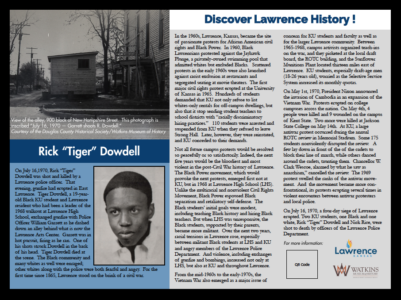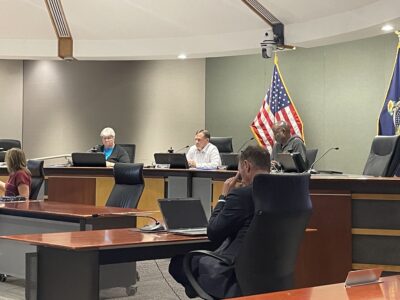Booze brothers
Despite Prohibition, creative Lawrence drinkers siphoned steady supply of bootlegged liquor from secret suppliers
Cliff McDonald once loaned $100 to a friend so he could bail his son out of jail.
The son’s crime: bootlegging.
“He still owes me $100, but he’s dead now,” McDonald says.
Prohibition in Kansas – which began 125 years ago today – stymied alcohol consumption in the state during the last part of the 19th century and half of the 20th century.
But in Lawrence, like most parts of the state, it was far from impossible to get a drink. You just had to be a bit more creative going about it.
“Anybody knew where to go and get a jug of beer,” says McDonald, who has lived all of his 80 years in Lawrence.
Bootlegging remained an industry in Kansas through various incarnations of Prohibition:
¢ Beginning in 1881, when Kansas became the first state to make alcohol consumption illegal.
¢ Beginning in 1919, when the nation followed suit.
¢ Again in 1933, when national prohibition was scrapped but Kansas kept its law on the books.
¢ After 1948, when Kansas voted to allow packaged liquor.

Lawrence law enforcement pour bottles of illegal liquor down the sewer drain outside the sheriff's headquarters in this undated photo.
“I think it was everywhere,” says Ken Peak, author of “Bootlegging in Kansas” and several articles on the topic. “If you had two barrels and a wooden plank, you had the fixins for a saloon.”
Prohibitionist past
Like most of the state, sentiment in Lawrence over prohibition was split. On one hand, Lawrence was home to one of the early challengers of the state’s prohibition laws, John Walruff, who continued to brew beer even after it became illegal.
He instigated a series of court challenges but eventually moved the operation to Kansas City, Mo. However, he continued to fill orders from there and ship them to Kansas.

Lawrence law enforcement pose with 200 quarts of illegal whiskey confiscated in a raid in this photo dated April 5, 1927. The photo was taken outside the police headquarters. The man seated on the running board is Will Johns, chief of police.
“Public sentiment is largely in his favor,” the Lawrence Tribune reported in 1886. “His patronage in this city is immense. His wagons deliver thousands of bottles of beer to hundreds of the best families in the city. Thousands of gallons of his beer (are) sent all over the state. The more he is enjoined, arrested and fined, the more his business increases.”
On the other hand, Lawrence was the center of plenty of temperance activity, even before prohibition was adopted. In 1874, the national Womens Crusade brought its peaceful protests to Lawrence.
“It was particularly interesting because you had women marching into saloons, praying and singing hymns,” says Nancy Garner, a history professor at Wayne State University who has studied the temperance movement. “It created quite a sensation.”
Key dates in prohibition
1880
Kansas becomes first state to adopt a constitutional amendment prohibiting alcohol.
1881
Alcohol ban goes into effect.
1890
“Supreme Court saloons” spring up after ruling allows importation of liquor in “original packages.”
1900
Carry Nation, of Medicine Lodge, begins her high-profile smashing of Kansas taverns.
1919
The 18th Amendment to the U.S. Constitution is passed, making Prohibition the law of the land. It took effect Jan. 16, 1920.
1933
21st Amendment to the U.S. Constitution approved, repealing Prohibition.
1937
Kansas Legislature loosens liquor laws to allow the sale of beer with 3.2 percent alcohol content.
1948
Kansans vote to repeal state constitution’s ban on alcohol, legalizing the sale of packaged liquor. Vote is 422,294 in favor of repealing the ban, 358,310 opposed.
1965
Legislature votes to allow private clubs to sell alcohol. Patrons had to pay membership fees, and bar owners would buy liquor from retail stores. Customers purchased mix to add to the liquor they owned at the pub.
1979
Attorney general’s opinion leads to the passage of a law allowing sale of liquor by the drink in private clubs.
1986
State passes liquor by the drink, to be determined on a county-by-county basis. Only 39 out of 105 counties voted for it in 1986; 32 counties still don’t allow liquor by the drink.
Sources: “Voices” magazine, Kansas Department of Revenue
She says the protests – and the attention they received – did shut down some bars in Kansas temporarily. But with a recession starting and a grasshopper plague bearing down on the state that year, residents’ minds soon turned to other matters.
Lawrence also garnered attention in 1878, when prohibition advocates organized a 12-day National Temperance Camp Meeting at Bismarck Grove, two miles northeast of town.
The meeting drew nearly 100,000 people, according to “Prohibition in Kansas,” by Robert Smith Bader.
Another Lawrence connection to prohibition was Gov. Walter Stubbs, a Lawrence contractor and staunch opponent of alcohol consumption.
He served as governor from 1909 to 1913 and worked to crack down on bootlegging in the Crawford County area known as the “Little Balkans,” where immigrants who were hired to work in strip mines made whiskey to supplement their incomes.
“(Stubbs) was very in favor of prohibition,” says Peak, a criminal justice professor at the University of Nevada-Reno. “The Balkans drove him absolutely nuts. He had his hands full and sent people down to the Balkans to clean it up, but they couldn’t do anything.”
Lawrence liquor
In most of Kansas, Peak says, it wasn’t too tough to make whiskey. Most hardware stores sold charcoal-lined barrels, brass coils, large quantities of sugar and other necessities for bootlegging.
Elfriede Fischer Rowe, a longtime Lawrence historian and author who was born in 1896 and died in 1992, recalled Lawrence men – never women – making plenty of their own beer and wine.
“Quite a few grapes were grown in those years in and around Lawrence,” she wrote in “Wonderful Old Lawrence.” “One thing was for sure, you always knew who was making wine, because the minute you stepped in a house, those little gnats that fly around fruit would greet you at the front door.”
During the 1930s and 1940s, McDonald recalls, most of the alcohol around Lawrence was shipped in from elsewhere – including the hopping southeast corner of the state – and sold at illegal taverns. Though there were a few in East Lawrence, the biggest operation was near Highway 32 just across the county line in Leavenworth County.
“It was a house that had slot machines and just about anything you’d want to drink,” he says.
He shies away from giving too many specifics about the operation, saying “some of these cats are still running around here.” But in the day, he says, they went by nicknames like “Big Tom,” “Dummy,” “Pickle” and “The Bee.”
McDonald says the saloon was run by honorable men.
“Their word was good,” he says. “That was it.”
He says law enforcement rarely made large liquor busts. One high-profile raid, though, came in 1948 – shortly before state prohibition was overturned – when officers destroyed 300 quarts of illegal liquor, according to “Lawrence: An Informal History” by David Dary.
“They had to make a show every once in a while,” says McDonald, whose family owned a beer distribution company for 65 years after prohibition on beer was lifted.
But he adds: “Even the cops liked a drink every once in awhile.”







